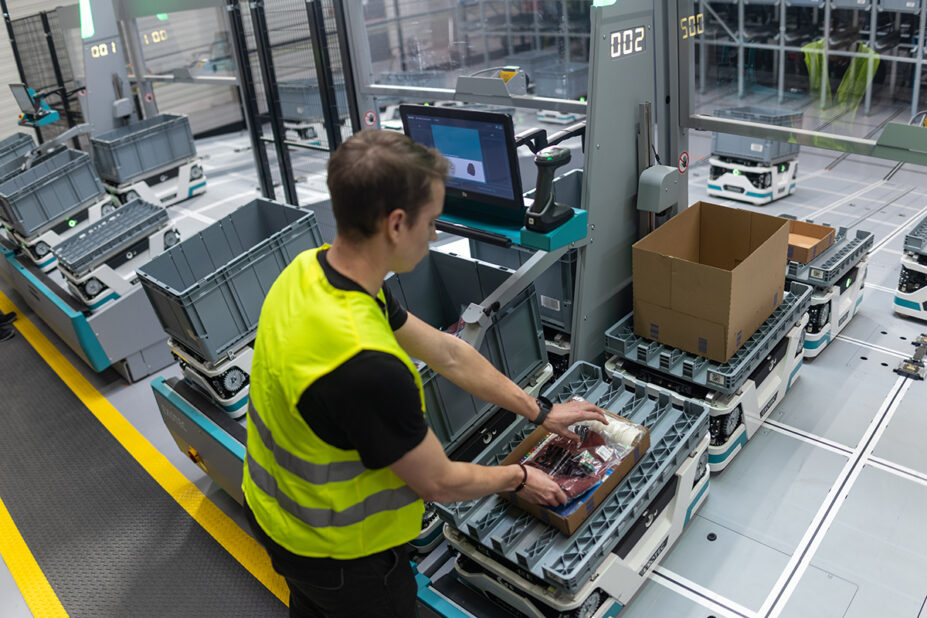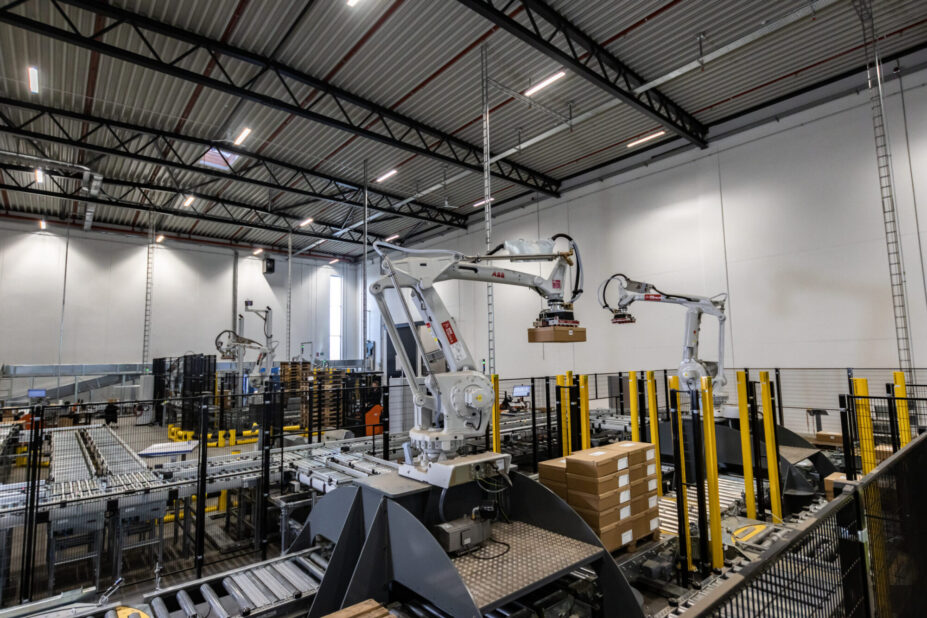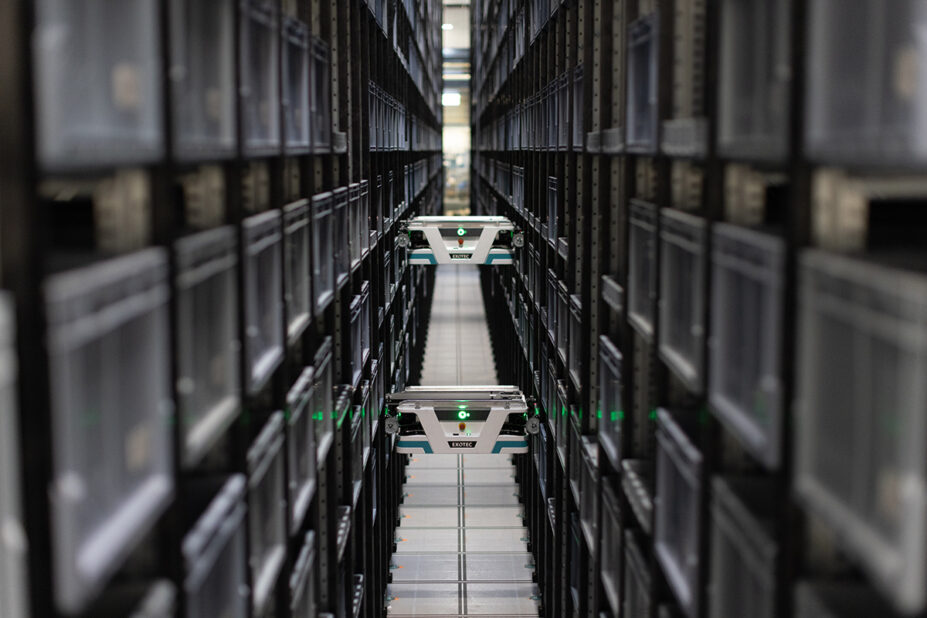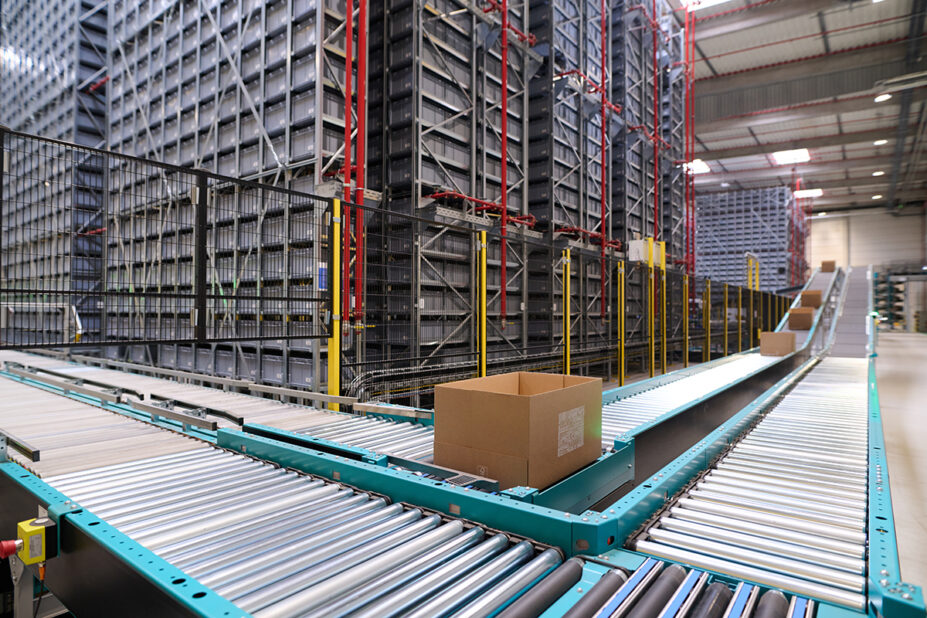Behind every warehouse shipment is a well-orchestrated dance of pallets, pickers, and machinery—all working together to get goods out of the warehouse and into the customer’s hands. And now, automation is stepping into the spotlight as a key player in that performance. From reducing manual labor to speeding up fulfillment times, automated systems are helping warehouses work smarter, not harder. In this article, we’ll break down the basics of warehouse material handling, highlight the biggest benefits, and explore how automation is reshaping the way goods move.

What is Material Handling
Material handling is at the core of every warehouse. It’s all about moving, storing, and protecting goods as they travel from production to distribution. The goal? Get the right items to the right place at the right time—without wasting time, money, or energy. Done right, it keeps operations running smoothly, cuts down on damage and delays, and helps teams pick, pack, and ship orders faster and more accurately.
Warehouse Automation Across Key Material Handling Processes
Warehouses leverage automation throughout operational workflows, creating efficiencies at each of the following stages of material handling.
Receiving & Unloading:
In warehouse receiving areas, conveyor systems and autonomous forklifts can be used to transport goods from dock to inventory staging zones. Barcode scanners and RFID technology automate inventory identification, eliminating manual data entry. Robotic depalletizers are increasingly used to unload inventory from pallets or transfer goods from cases into bins before sending them into storage.
Storage & Picking:
There are a variety of advanced automation solutions for inventory storage and order picking such as Automated Guided Vehicles (AGVs) and Autonomous Mobile Robots (AMRs) that navigate warehouse floors to transport goods between storage and picking areas. There are also a variety of Automated Storage & Retrieval Systems (AS/RS) including:
- Vertical Lift Modules: Store items vertically inside an enclosed cabinet, using a rotating carousel motion to store inventory and present ordered goods to system operators.
- Cube Based Systems: Store inventory in a three-dimensional grid structure, with robots that navigate on top of the grid to stack and destack bins for item retrieval and placement.
- Mobile AS/RS: Use robots to move goods between storage racks and picking stations, while handling processes like picking, packing, buffering, and sequencing orders.
AS/RS deliver the highest levels of material handling performance through dense storage and high-speed retrieval, enabling maximum space utilization and throughput with minimal manual handling.
Packing:
For packing processes, machines handle sealing, labeling, and boxing items. Scan and weigh systems verify package contents and prevent errors before products advance through conveyor sortation systems toward shipping zones.
Sorting & Staging:
Automated sortation systems use barcode or RFID scanners to quickly identify each item and direct it to the correct lane—whether it’s for packing, shipping, or another processing area. Instead of workers manually sorting products, conveyor belts and diverters move items to the right spot with speed and precision, making the sorting and staging process faster, more organized, and less error-prone.
Shipping & Loading:
In shipping departments, conveyor-to-truck loading systems accelerate outbound movement. Dock scheduling software optimizes loading bay usage, and load scanners provide verification before departure.
Inventory Management:
Throughout the facility, inventory management benefits from RFID tracking for location visibility. Automated cycle counting via robots improves accuracy while reducing labor costs, and integrated warehouse management systems centralize control across functions.

The Software Powering Material Handling Automation
Within automated warehouses is a network of intelligent software systems that coordinate warehouse operations in real time. These systems serve as the digital backbone of material handling automation, ensuring everything runs smoothly, efficiently, and with minimal human intervention.
Warehouse Management System (WMS):
The WMS oversees high-level warehouse operations—tracking inventory, managing stock locations, and orchestrating the flow of goods from receiving to shipping. It determines what needs to be done and when, such as which orders to prioritize, how much inventory to replenish, or where to store incoming goods.
Warehouse Execution System (WES):
While the WMS plans, the WES acts. This system bridges the gap between high-level planning and real-time operations by directing the activity of automated systems such as AS/RS, AMRs, and conveyor networks. A WES makes decisions on the fly—like sequencing picks for maximum efficiency, balancing workloads across zones, or dynamically rerouting tasks to avoid bottlenecks.
Warehouse Control System (WCS):
The WCS interfaces directly with automation hardware—controlling the movement of conveyors, sorters, and robotic arms. It ensures these machines follow precise instructions from the WES and operate in harmony with the overall warehouse flow.
Together, these software systems form a layered control structure:
- The WMS tells the warehouse what to do.
- The WES decides how and when to do it.
- The WCS tells the machines how to move and act.
By tightly integrating software and automation, warehouses gain real-time visibility, coordinated workflows, and the flexibility to adapt to changing demands—whether it’s a sudden surge in order volume or a shift in shipping priorities.
Benefits of Material Handling Automation
Get Orders Out Faster:
Speed is everything in today’s fulfillment landscape. Material handling automation helps warehouses move orders through the warehouse and out the door faster than ever. From robotic picking arms that can achieve over 2,000 picks per hour to conveyor sortation systems that route packages at speeds of up to 300 feet per minute, every step is engineered for high-volume throughput.
For example, Lane Automotive significantly improved their operations by fully automating their warehouse with the Exotec Skypod system as the core AS/RS technology. They cut their order fulfillment time—from the start of picking to loading onto a trailer—from an average of 109 minutes to just 15 minutes. This boost in efficiency helps them ship orders faster and handle more volume per shift, all without needing additional labor.
Automate the Heavy Lifting:
Automation is ideal for repetitive, labor-intensive tasks in the warehouse. Inventory storage and order picking are two key processes that benefit the most. When automation handles these tasks, it reduces the need for manual labor and allows teams to focus on higher-value work.
Build Up, Not Out:
High-density storage solutions take advantage of vertical space, reducing the need for wide, sprawling layouts. This creates room to support other critical functions like quality control, order customization, or kitting—without expanding the facility’s footprint.
Get It Right, Every Time:
Material handling automation eliminates manual guesswork, ensuring precise inventory tracking and movement. Advanced systems—such as warehouse management systems (WMS), RFID scanners, barcode readers, and real-time location systems (RTLS)—monitor goods in real time, keeping them in the right place at the right time and improving overall order accuracy.
Protect People:
Safety improvements are a key outcome of effective material handling automation. By reducing the need for manual lifting, repetitive motion, or operation in high-traffic zones, automation can lower the incidence of workplace injuries and create a safer environment for personnel.

5 Steps for a Successful Material Handling Automation Project
1. Build a Strong Business Case
Identify the core problems you’re solving—whether it’s limited processing capacity, storage constraints, or labor inefficiencies. Define what success looks like and what you risk by doing nothing.
2. Set Clear Requirements and Success Metrics
Outline key design parameters like channels, SKUs, and business units. Establish measurable KPIs (e.g., throughput, accuracy, cost per order) to track progress before and after implementation.
3. Align Stakeholders and Resources
Assess your company’s readiness—systems, staffing, and automation maturity. Build a cross-functional team with clear roles, responsibilities, and scope boundaries.
4. Communicate and Plan the Transition
Create a communication plan that reaches all levels—from leadership to frontline workers. Develop a detailed transition plan covering inventory, suppliers, systems, and data migration.
5. Train, Support, and Continuously Improve
Provide targeted training, develop internal “superusers,” and share performance updates regularly. Keep feedback loops open with your automation provider to drive future improvements and upgrades.

Fulfilling Orders at Ariat Using the Exotec Skypod System
Real-World Case Study: How Ariat Transformed Apparel Fulfillment with Automation
Company Background:
Ariat is a leading provider of Western and English-style riding boots, apparel, workwear, and accessories. Its distribution network serves more than 6,500 retail locations throughout the U.S., Europe, Mexico, and Japan, as well as a growing online customer base.
The Challenge:
Ariat’s rapid sales growth, increasing customer expectations, and expanding product catalog led to the construction of a one-million-square-foot central distribution center in Fort Worth, TX, in 2020. Initially using manual picking methods, they needed a higher-performing and more flexible fulfillment solution for apparel orders that could:
- Efficiently handle their large and evolving SKU count
- Reduce physically demanding tasks like extensive walking and heavy lifting
- Integrate effectively with existing systems
- Scale as their business continued to grow
As Matt Hardenberg, Vice President of Distribution at Ariat, explained: “We’ve seen an expansion of what our customers’ expectations are on both the business and consumer side. That has put a lot of stress on our distribution network. Also, as the company and all of our channels have grown, it has expanded the different types of fulfillment we do out of our centers.”
The Solution:
Ariat implemented the Skypod System with the following specifications:
- 86 robots
- 7 picking stations
- 2 replenishment stations
- 71,785 storage bins
- 1,958 bins processed per hour
- 11m (36 ft) rack height
- 2,696 m² (29,019 ft²) system footprint
The system was integrated by Hy-Tek Intralogistics.
Results:
- Dramatic Efficiency Improvements
- Goods-to-person system enabled processing over 1,650 lines per hour with just seven employees
- Picking rate increased by 10x
- 80% of picking labor was transitioned to more productive, value-added tasks
- Gained the ability to efficiently manage seasonal peaks while fulfilling tens of thousands of SKUs daily
- Modular Implementation
- Installation completed on schedule in just 11 months despite pandemic logistics challenges
- System expansion from 57 to 86 robots completed in minutes during 2022
- Enhanced Customer Service
- B2C offerings expanded to include next-day shipping
- Later order cut-off times became possible

Common Questions About Material Handling Answered
What is the difference between material handling and logistics?
Material handling refers to the physical movement and storage of goods within a facility, whereas logistics encompasses the broader planning and coordination of product movement across the entire supply chain, including transportation and distribution.
How does automated material handling impact staffing?
Automation doesn’t eliminate the need for human workers—it transforms their roles. While fewer manual pickers may be needed, demand often increases for skilled technicians, system operators, and data analysts. Upskilling existing staff to manage, maintain, and interpret data from automated systems is a crucial part of workforce planning.
Is automation viable for small or mid-sized operations?
Yes. Thanks to modular and scalable technologies, automated material handling systems are no longer reserved for large-scale operations. Systems can now be tailored to match facility size and throughput requirements, allowing smaller operations to improve efficiency without over-investing.
What types of material handling are best suited for e-commerce fulfillment?
E-commerce warehouses often benefit from goods-to-person systems, automated sortation, and mobile robotics due to high SKU variability and fast order turnaround times. These technologies reduce walking time, improve accuracy, and scale quickly with demand.
What factors drive the ROI of a material handling system?
Key ROI drivers include labor savings, increased throughput, reduced error rates, better space utilization, and meeting customer expectations around shipping speed and accuracy. The payback period will vary based on the complexity and scope of the system.
How do material handling systems integrate with existing WMS platforms?
Most modern systems are designed with APIs or middleware for seamless integration with WMS, ERP, and inventory systems. Successful integration ensures that automated hardware works with software for synchronized task execution, inventory updates, and order tracking.
What maintenance considerations come with automated material handling?
Preventive maintenance schedules, access to spare parts, and vendor support are critical. While many systems are highly reliable, having trained in-house technicians or rapid-response service agreements can minimize downtime and maintain operational continuity.
How flexible are automated systems to changes in demand or inventory mix?
Flexibility depends on system design. Solutions like robotic shuttles or AMRs tend to be more adaptable to layout changes and SKU variability, while fixed-path systems may require more planning and capital to adjust.
These are just a few questions decision-makers face when evaluating or managing material handling systems. As automation evolves, staying informed about operational and strategic implications becomes increasingly essential.
Choosing the Right Automation Partner for Your Warehouse
Selecting the right provider requires a strategic look at how a potential partner’s technology aligns with your operational goals, scale, and long-term growth. A successful partnership is built on ongoing support, flexibility, and a shared understanding of fulfillment dynamics.

The Exotec Skypod System Advantage: Unified Process Automation
The Exotec Skypod system is an AS/RS that goes beyond traditional storage and picking by also handling packing, buffering, sorting, and sequencing in one solution. This simplifies order fulfillment by eliminating the need for separate subsystems like staging zones for buffered orders or sorters, saving time and space while increasing fulfillment speed.
To see how automation can enhance your warehouse performance, take a virtual tour of an Exotec-powered facility.
Featured In
Share
Insights
-
April 15, 2025Top Warehouse Trends for 2025: Future of Automation
-
April 4, 2025Complete Guide to Pick-and-Place Automation
-
February 20, 2025What Is 3PL? Understanding the Role of Third-Party Logistics
News
-
March 24, 2025Exotec Showcases Next-Gen Skypod System at ProMat 2025
-
March 17, 2025Exotec Announces Partnership with Oxford Industries to Implement Next Generation Skypod System in New Multi-Brand Distribution Center
-
February 27, 2025Colruyt‘s Collect&Go continues its automation journey with Exotec
Events
-
April 16, 2025 | Grand Rapids, MIExotour: Grand Rapids, MI
-
May 7, 2025Exodinner: Indianapolis, IN
-
May 22, 2025 | Cincinnati, OHExotour: Cincinnati, OH